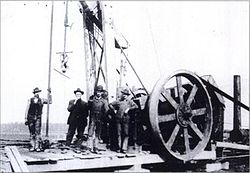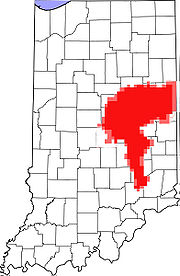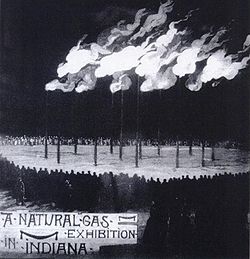
Indiana Gas Boom
Encyclopedia

Natural gas
Natural gas is a naturally occurring gas mixture consisting primarily of methane, typically with 0–20% higher hydrocarbons . It is found associated with other hydrocarbon fuel, in coal beds, as methane clathrates, and is an important fuel source and a major feedstock for fertilizers.Most natural...
in the Trenton Gas Field
Trenton Gas Field
The Trenton Gas Field is located in east central Indiana and the most western portion of west central Ohio. The field was discovered in 1876, but the size and magnitude of the field was not known until the 1880s. The field was the largest natural gas discovery up to that time, containing over of...
, in the US state of Indiana
Indiana
Indiana is a US state, admitted to the United States as the 19th on December 11, 1816. It is located in the Midwestern United States and Great Lakes Region. With 6,483,802 residents, the state is ranked 15th in population and 16th in population density. Indiana is ranked 38th in land area and is...
and the adjacent northwest part of Ohio
Ohio
Ohio is a Midwestern state in the United States. The 34th largest state by area in the U.S.,it is the 7th‑most populous with over 11.5 million residents, containing several major American cities and seven metropolitan areas with populations of 500,000 or more.The state's capital is Columbus...
The boom began in the early 1880s and lasted into the early twentieth century.
When the Indiana natural gas
Natural gas
Natural gas is a naturally occurring gas mixture consisting primarily of methane, typically with 0–20% higher hydrocarbons . It is found associated with other hydrocarbon fuel, in coal beds, as methane clathrates, and is an important fuel source and a major feedstock for fertilizers.Most natural...
belt was discovered, the citizens were unaware of what they had found; nearly a decade passed without action to recover the resource. Once its significance was realized, further exploration showed the Indiana gas belt was the largest deposit of natural gas discovered until then. In addition to the massive quantity of natural gas, in the 1890s developers discovered that the field also contained the first giant oil reserve found in the United States, with an estimated one billion barrels of oil. The resource was rapidly tapped for use. Because the gas was being wasted in use, the Indiana General Assembly
Indiana General Assembly
The Indiana General Assembly is the state legislature, or legislative branch, of the state of Indiana. It is a bicameral legislature that consists of a lower house, the Indiana House of Representatives, and an upper house, the Indiana Senate...
attempted to regulate its use. In a series of cases, the Indiana Supreme Court ruled against the state's attempt at regulation, and waste continued.
The poor understanding of oil and gas wells at the time led to the loss of an estimated 90% of the natural gas by venting into the atmosphere or by widespread misuse. By 1902 the yield from the fields began to decline, leading to a switch to alternative forms of energy. With most of the gas removed from the field, there was no longer enough pressure to pump the oil out of the ground. An estimated 900 Moilbbl of oil remain in the field. Advancements in artificial lift
Artificial lift
Artificial lift refers to the use of artificial means to increase the flow of liquids, such as crude oil or water, from a production well. Generally this is achieved by the use of a mechanical device inside the well or by decreasing the weight of the hydrostatic column by injecting gas into the...
technology have led to extraction of some of the oil, but at a relatively slow rate and high cost compared to more productive fields.
Discovery

Coal
Coal is a combustible black or brownish-black sedimentary rock usually occurring in rock strata in layers or veins called coal beds or coal seams. The harder forms, such as anthracite coal, can be regarded as metamorphic rock because of later exposure to elevated temperature and pressure...
miners in the town of Eaton
Eaton, Indiana
Eaton is a town in Union Township, Delaware County, Indiana, along the Mississinewa River. The population was 1,805 at the 2010 census. It is part of the Muncie, IN Metropolitan Statistical Area.-History:...
were boring a hole in search of coal. After they reached a depth of about 600 feet (182.9 m), a loud noise came from the ground and a foul odor came from the hole. The event scared the miners. Some believed that they had breached the ceiling of Hell
Hell
In many religious traditions, a hell is a place of suffering and punishment in the afterlife. Religions with a linear divine history often depict hells as endless. Religions with a cyclic history often depict a hell as an intermediary period between incarnations...
. They plugged the hole and did not drill any more at that location.
In 1884, natural gas was discovered in Ohio
Ohio
Ohio is a Midwestern state in the United States. The 34th largest state by area in the U.S.,it is the 7th‑most populous with over 11.5 million residents, containing several major American cities and seven metropolitan areas with populations of 500,000 or more.The state's capital is Columbus...
and the news of the discovery was published in the local Indiana newspapers. Residents of Eaton remembered the early incident near their town and realized the magnitude of the discovery. Returning to the site, a company reopened the hole and drilled down another 322 feet (98.1 m) deeper, releasing a large amount of gas. When the escaping gas was ignited, the flame reached twelve feet into the air and could be seen from the neighboring town of Muncie
Muncie, Indiana
Muncie is a city in Center Township, Delaware County in east central Indiana, best known as the home of Ball State University and the birthplace of the Ball Corporation. It is the principal city of the Muncie, Indiana, Metropolitan Statistical Area, which has a population of 118,769...
.
Gas fever swept the state and thousands of gas wells were created. Explorers found that the gas field was the largest of natural gas fields found up to that date, covering an area of 2500 square miles (6,475 km²). The belt came to be called the Trenton Gas Field
Trenton Gas Field
The Trenton Gas Field is located in east central Indiana and the most western portion of west central Ohio. The field was discovered in 1876, but the size and magnitude of the field was not known until the 1880s. The field was the largest natural gas discovery up to that time, containing over of...
. Drillers found large quantities of oil in addition to the natural gas. The Trenton Gas Field was almost completely interconnected, so a well at any one location lowered pressure across the entire field. Whenever new holes were bored, a pipe was created off the main line. It was lit with a constant flame as proof that the gas was flowing. Although burning such a flame wasted massive amounts of the resource, the practice became common. The constant burning gas flame was called a flambeau
Flambeau
Flambeau may refer to:* A burning torch, especially one carried in procession* Flambeau , a character in G. K. Chesterton's Father Brown stories* The Flambeau River, in northern Wisconsin* Flambeau, Rusk County, Wisconsin...
.
Boom

Ball Corp.
Ball Corporation , originally Ball Brothers Glass Manufacturing Company, is an American company famous for producing glass canning jars. Founded in 1880, it is currently headquartered in Broomfield, Colorado. The company has expanded into other areas such as avionics, space systems, metal beverage...
opened in Muncie, using the cheap fuel to make glass. Other manufacturers also moved into the area, including the Kokomo Rubber Company; Hemmingray Bottle and Insulating Glass Company; and Maring, Hart, and Company.
Iron and other metal manufacturers set up large factories attracted by the cheap fuel. The cheap fuel was a primary reason that U.S. Steel
U.S. Steel
The United States Steel Corporation , more commonly known as U.S. Steel, is an integrated steel producer with major production operations in the United States, Canada, and Central Europe. The company is the world's tenth largest steel producer ranked by sales...
chose northern Indiana for their operations. Other cities across northern Indiana also grew, including Hartford City
Hartford City, Indiana
Hartford City is a city in the U.S. state of Indiana, and the county seat of Blackford County. Located in the northeast central portion of the state, the small farming community experienced a 15-year “boom” beginning in the late 1880s...
and Gas City
Gas City, Indiana
-Demographics:As of the census of 2000, there were 5,940 people, 2,393 households, and 1,643 families residing in the city. The population density was 1,599.2 people per square mile . There were 2,497 housing units at an average density of 672.3 per square mile...
. Gas City was in the center of the gas field and had access to the strongest pressures, with between 300 pound per square inches (2,068.4 kPa) and 350 pound per square inches (2,413.2 kPa). In 1892 Gas City had a population of 150, but two years later its population had increased to 25,000.
Cities outside the field were piped gas, and the fuel was exported across the Midwest. The Indiana Natural Gas and Oil was formed by a group of Chicago
Chicago
Chicago is the largest city in the US state of Illinois. With nearly 2.7 million residents, it is the most populous city in the Midwestern United States and the third most populous in the US, after New York City and Los Angeles...
businessmen led by Charles Yerkes
Charles Yerkes
Charles Tyson Yerkes was an American financier, born in Philadelphia. He played a major part in developing mass-transit systems in Chicago and London.-Philadelphia:...
. The company hired Elwood Haynes
Elwood Haynes
Elwood P. Haynes was an American inventor, metallurgist, automotive pioneer, entrepreneur and industrialist. He invented the metal alloys stellite and martensitic stainless steel and designed one of the earliest automobiles made in the United States...
as their superintendent and he oversaw the laying of the fist long distance natural gas pipeline in the United States, connecting Chicago with the Trenton Field over 150 miles (241.4 km) away. One major use for the gas was to power lighting
Gas lighting
Gas lighting is production of artificial light from combustion of a gaseous fuel, including hydrogen, methane, carbon monoxide, propane, butane, acetylene, ethylene, or natural gas. Before electricity became sufficiently widespread and economical to allow for general public use, gas was the most...
. The wealth and industry brought by the wells led to a rapid population shift into northern Indiana. Southern Indiana, by comparison, had never recovered from the embargo during the Civil War and was in economic decline. The northern part of the state attracted new jobs. The boom led to rapid development of pumping and piping technology by the regions gas and oil companies. Inventors, like Elwood Haynes
Elwood Haynes
Elwood P. Haynes was an American inventor, metallurgist, automotive pioneer, entrepreneur and industrialist. He invented the metal alloys stellite and martensitic stainless steel and designed one of the earliest automobiles made in the United States...
developed many different devices and methods that advanced the industry.
As the use of the gas grew, many scientists warned that more gas was being wasted than was effectively used by industry, and that the supplies would soon run out. Almost every town in northern Indiana had one or more gas wells. Producers lit a flambeau at the top of each well to show the gas was still flowing. The Indiana General Assembly
Indiana General Assembly
The Indiana General Assembly is the state legislature, or legislative branch, of the state of Indiana. It is a bicameral legislature that consists of a lower house, the Indiana House of Representatives, and an upper house, the Indiana Senate...
attempted to stop the practice by limiting open burning. The law met with tough opposition. Many town leaders, who had come to rely on the gas revenues dismissed claims that the wells would run dry. This practice wasted much gas; INGO conducted its own investigation and found that its flambeaus wasted $10,000 in gas daily, and ordered the practice stopped. Despite their findings, the other companies did not follow their example. Although INGO implemented anti-waste measures, they were virulently opposed to the regulations that they viewed as hampering to productivity—primarily the regulations aimed at artificially increasing gas pressure.
Elwood Haynes filed a suit a month after the regulations were passed into law, claiming that the government had no authority to regulate the industry. The challenge dragged on in court for several years until the Indiana Supreme Court declared the regulatory laws unconstitutional
Constitution of Indiana
There have been two Constitutions of the State of Indiana. The first constitution was created when the Territory of Indiana sent forty-three delegates to a constitutional convention on June 10, 1816 to establish a constitution for the proposed State of Indiana after the United States Congress had...
in 1896. The flambeau practice continued and grew in popularity. Several towns set up elaborate flambeau displays containing dozens of flames, designed to attract tourists. Other towns set up multiple arches over streets with smaller flambeaus that burned day and night.
Almost every community in the Trenton Field had a gas well. Many were purchased by local governments, which used revenues for community amenities. Many towns and cities installed free gas lighting throughout their communities, supplied by their own gas wells. Communities also piped gas to private homes to provide cheap heating fuel, helping to make urban living more desirable. Gas was used to produce electricity that ran electric street cars in several cities. Businessmen also established corporations to purchase the gas from the local markets and sell it wholesale on the national market.
Decline
Wasteful practices rapidly depleted the gas field. By the turn of the century, output from the wells began to decline. Some flambeaus had been burning for nearly two decades; slowly their flames became shorter and weaker. Modern experts estimate that as much as 90% of the natural gas was wasted in flambeau displays. By 1903 factories' and towns' need for alternate sources of energy led to creation of numerous coal-burning electric plants.Oil lasted a few years longer, but inexperience in the early oil drilling industry led to problems. Producers were unaware of the relation between the pressure provided by natural gas and the ability to pump oil from wells. The pressure began to decline rapidly towards the turn of century. In 1895 the pressure was at 164 psi
Pounds per square inch
The pound per square inch or, more accurately, pound-force per square inch is a unit of pressure or of stress based on avoirdupois units...
, in 1897 it was 191 psi, in 1898 173 psi. As the pressure decreased to around 150 psi, oil began to move into the upper part of the field, but since the natural gas had been released and pressure dropped between 130 psi, there was no way to pump out the remaining oil in the field.
Oil production in Indiana peaked in 1905 with over 11 Moilbbl pumped that year. By 1910 the once abundant resources had slowed to a trickle. By then new industry had moved into the state, and decline of the gas industry did not have a major negative impact. The availability of cheap energy had drawn so much new industry that Indiana had become one of the leading industrial states. The economy of northern Indiana continued to flourish until the Great Depression
Great Depression
The Great Depression was a severe worldwide economic depression in the decade preceding World War II. The timing of the Great Depression varied across nations, but in most countries it started in about 1929 and lasted until the late 1930s or early 1940s...
began in the following decade. In total, over 1 Tcuft of natural gas and 105 Moilbbl of oil are estimated to have been extracted from the field.
Smaller pockets of natural gas exist in Indiana at depths that could not be reached in the boom era. The state still had a small natural gas producing industry in 2008, but residents and industry consume about twice as much natural gas as the state produces. In 2005 there were 338 active natural gas wells on the Trenton Field. In 2006 Indiana produced more than 290 million cufts (8,211,885.6 m³) of natural gas. This made it the 24th largest producing state, far below the major producers.
It is estimated that only 10% of the oil was drilled from the Trenton Field, and approximately 900 Moilbbl may remain. Because of the size of the field, pumping gas back into the well to increase pressure, as is commonly done in smaller fields, is impossible. Because of the depth and limitations of hydraulic pumps, it was never cost effective to use them to extract oil. It was not until the 1990s that efficient methods of artificial lift were discovered. This has allowed some of the oil to extracted, but at far higher cost than when sufficient natural gas is present.
External links
- Oil and Gas in Indiana
- "Natural Gas Boom, Tipton County," poem by Jared CarterJared Carter-Background:Carter studied at Yale and at Goddard College. After military service and travel abroad, he made his home in Indianapolis, where he has lived since 1969...

